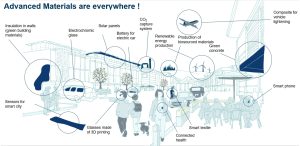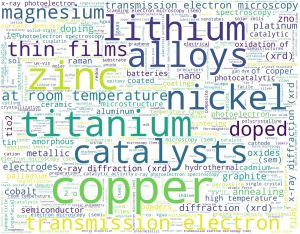Marie-Pierre Ippersiel, CEO and President of PRIMA Québec, explains how the organisation is working to drive innovation in advanced materials within Québec and beyond.
Used in energy, transport, health, defence, technology, and many more sectors, advanced materials play a crucial role in today’s world. They are new or improved materials that offer greater performance than previous materials. Capabilities include, for example, the ability to withstand unprecedented temperature variations, recreate skin, and replace polluting materials.
Dedicated to supporting and facilitating the advanced materials ecosystem, PRIMA Québec acts as a catalyst between the industrial and research communities to promote collaborative innovation in advanced materials. The Innovation Platform spoke to Marie-Pierre Ippersiel, CEO and President of PRIMA Québec, to learn more about the organisation and how it is collaborating to position Québec as a hub for advanced materials innovation.
Can you briefly outline PRIMA as an organisation and how it is supporting innovation in additive manufacturing and advanced materials?
PRIMA – the Advanced Materials Research and Innovation Hub – is a sector-based industrial research cluster. Our mission is to support and facilitate the advanced materials ecosystem by promoting collaborative innovation for the economic development of Québec. Primarily, we foster collaborative innovation mainly between academics and firms to enhance their innovation capacity and competitiveness on the markets.
Over the last ten years (2015-2025), PRIMA has funded more than 200 projects with a total value of C$196m, involving over 310 industrials partners and 34 academic institutions. These projects generated 494 scientific publications, 111 intellectual property (industrial secrets, patents filed, licenses granted, invention declarations) and trained over 900 higher qualified personnel. This last point is particularly important, as this ensures the transfer of knowledge and knowhow to companies that have every interest in hiring them. Funding for these projects is made possible thanks to our financial partner, the Québec Ministry of Economy, Innovation, and Energy.

Advanced materials can be organised into the following categories:
Basic materials: Materials found upstream in the manufacturing chain that have undergone little or no transformation.
Finished/semi-finished products in which advanced materials are integrated.
Processes and instrumentation.
The latter category refers to nano, micro fabrication but also to additive manufacturing. The main thing to remember is that, when we think of advanced materials, the processes are never far behind. Québec can count on more than 570 firms, mostly SMEs, that are very active in R&D. The ecosystem is presented in the report Advanced materials – Québec Innovation in Action.
Additive manufacturing (AM) is at the heart of disruptive technologies, and its technological potential will produce unique product designs while reducing time to market and leveraging flexible, adaptive and cost-effective manufacturing methods. From an economic sustainability standpoint, AM helps companies better manage their energy transition and the pressures exerted on resources. It also promotes personalised medicine in the context of an aging population.
In 2020, PRIMA Québec and its partners published the first White Paper (French only) which created an initial profile of the sub ecosystem itself, along with its strengths and weaknesses, in an effort to identify various market opportunities and challenges. It also proposed strategic orientations and structuring measures that could increase Québec’s economic competitiveness and help it become a global technological leader through AM. Interestingly, Québec is home to two of the world’s largest manufacturers of metal powders for additive manufacturing: AP&C and Tekna.
Following the White Paper, in 2022 PRIMA Québec launched with its partners the Carrefour québécois de la fabrication additive (CQFA) – a structuring project that relies on sharing and consultation to stimulate the development of Québec’s AM ecosystem. The CQFA targets all the stakeholders (manufacturers, researchers, professionals, etc.) while focusing on Québec companies in the sector. It addresses every AM-related process and material, along with every aspect involved, including application, research and development, financing, entrepreneurship and technology adoption, as well as training and skills development.
What are the key sectors that you work across and how are your innovations helping to transform these sectors?
The vast majority of projects that have received financial support from PRIMA Québec are in the following application sectors: infrastructure and transportation, environment, energy, chemistry, and health. The following examples illustrate how the results are helping to transform several sectors.
More affordable, compact, and energy-efficient optical chips
A collaboration between the Université du Québec à Montréal (UQAM), AEPONYX (a Québec SME), and the Institut National de Recherche Scientifique – Centre Énergie Matériaux Télécommunications (INRS-EMT) has developed advanced nanomanufacturing processes to prototype integrated silicon nitride photonic devices. This research addresses the need to continually improve the capacity, quality, and energy efficiency of connections for the rapidly growing number of internet-connected devices. The project allowed academic and industrial researchers to use high-tech equipment and simulation software to build and characterise state-of-the-art prototypes, acquiring new technical expertise and understanding the challenges of optical communications and microsystem commercialisation.
The project significantly improved the performance of AEPONYX’s optical microswitch platform, leading to a new optical switch demonstration and facilitating a transition to commercial foundries. These efforts also resulted in a new generation of optical chips that are more affordable, compact, and energy-efficient, bolstering AEPONYX’s patent portfolio to 34 and solidifying its position as a world leader in next-generation telecommunications chips. Future work will focus on implementing new platform features to facilitate integrated optical chip packaging and investigate leveraging the platform’s capabilities to create new bandwidth and centre wavelength tuneable optical filters for tomorrow’s elastic optical networks.
The collaboration was instrumental in training students with advanced design and nanomanufacturing skills, with six of them joining the AEPONYX team. Furthermore, AEPONYX successfully raised C$21m to launch its commercialisation phase. The company is now planning to become a key player in Bromont’s innovation zone, Technum, where it intends to develop a much-needed supply chain for semiconductors.
Additive manufacturing for high-performance thermoplastic composite parts
Current commercial 3D printing technologies face several major limitations: they are typically closed source, restricting users to proprietary and costly materials; they offer limited control over manufacturing parameters; the parts produced often don’t meet industrial performance requirements; and their production cycles are not suited for large-scale manufacturing.
A research group, led by the National Research Council of Canada (NRC) and Polytechnique Montréal, partnered with numerous industrial companies to create an open-source 3D printing technology. This initiative aims to tackle technological hurdles by offering greater flexibility in material choice and enhanced process control precision. Key aspects of the technology include developing specially formulated materials for high-performance uses (especially in transportation), advanced systems for printing high-melting-point thermoplastics, multi-material printing, and the ability to use conventional pellets. The project also incorporates real-time monitoring, process modelling, and numerical simulation to optimise control and industrial performance.
This project made significant strides in additive manufacturing by creating innovative thermoplastic composites for 3D printing. It improved the quality and robustness of parts by using a radiation heating system to optimise interlayer adhesion. The process control is precise, thanks to printing process modelling and real-time monitoring with infrared cameras and optical coherence tomography. The developed materials incorporate reinforcements and additives and feature an ecological component through practical recycling and reuse demonstrations via fused filament fabrication (FFF). Ultimately, the effort yielded nine innovative technologies and eight new products, significantly enhancing the FFF process and opening doors for higher-performance industrial applications.
How is Canada’s collaboration with Horizon Europe helping to advance PRIMA’s capabilities and the projects it supports?
Canada’s collaboration with Horizon Europe enables PRIMA to lead and participate directly in large-scale research consortia under Pillar II, which addresses global challenges like climate, energy, and health.
PRIMA can build upon previous partnerships with European entities and networks, as PRIMA is already involved with co-funded programmes like M-ERA.NET3 and ERA-MIN3. The Horizon Europe framework programme now allows a global outreach inside Pillar II. PRIMA has access to direct funding, to a vast network of European partners, and a platform to showcase the expertise and broaden the scope of research of these industrial members, thereby fostering stronger international partnerships and driving innovation on a global scale.
PRIMA is now an associate member of the Innovative Advanced Materials for Europe (IAM4EU) Partnership – a co-programmed European partnership dedicated to advancing the design, development, and uptake of Innovative Advanced Materials (IAM) to support Europe’s twin green and digital transitions and the Clean Industrial Deal.
With advanced materials being transversal and crucial for collaborative projects addressing major societal challenges, Canada’s collaboration enables broader thematics to be tackled through an advanced materials approach. Due to the wide community of industrial PRIMA members, Horizon Europe gives access to strategic complementary topics such as health, digital transition, energy transition, circular economy, textiles, deep technologies like photonics, quantum and many more.
Finally, the main structuring activities – such as, networking, policy development, supply chains, road mapping, dissemination, and awareness-raising to support research and innovation ecosystems – make PRIMA an international key player for Coordination and Support Action (CSA), with many previous successes already published.
Why is international collaboration so important for the sector of advanced materials?
International collaboration is essential for the advanced materials sector because it allows researchers to combine global expertise, resources, and funding to tackle large-scale challenges that are too complex for any single entity to solve. It’s important to note the interdisciplinary nature of the sector, which draws from physics, chemistry, and engineering, makes diverse perspectives critical for fostering innovation.
Certain elements also somewhat justify the importance of collaboration. Complementary expertise and resources are needed, and several countries have developed unique strengths in materials science. For example, innovation (measured by patent family) in the field of composites, ceramics, metamaterials, nanomaterials, and polymers is concentrated in the US, followed by Japan, Germany, and South Korea.
Collaboration allows researchers to combine these complementary capabilities rather than duplicating efforts. Secondly, the specialised equipment needed for advanced materials research – like advanced characterisation instruments, synchrotron facilities, and high-performance microscopes – is extraordinarily expensive. International collaboration allows countries to share these costs and provide researchers worldwide with access to cutting-edge facilities they couldn’t afford individually.
According to a bibliometric and technometric study¹ on research and innovation in advanced materials in Québec, collaboration is crucial. Research on advanced materials generally involves collaboration between different actors. Whether in terms of international collaboration, collaboration between the public and private sectors, or multidisciplinary collaboration as measured by the disciplinary diversity of authors, Canada performs very well. It ranks sixth among countries with the highest rates of international or public-private collaboration, and seventh among countries with the highest rate of highly multidisciplinary publications.
What are your priorities for the rest of 2025 and beyond?
As Canada is seeking to achieve technological sovereignty in the current geopolitical context, we are convinced a collaborative innovation approach is the best way to strengthen the innovation ecosystem. PRIMA Québec intends to support and help in the daunting task with the assistance of other sector-based industrial research clusters such as CRIAQ, or PROMPT.
Advanced materials are essential for defence. They improve the performance, survivability, and capabilities of military equipment and personnel. These materials, which are far superior to conventional materials, have an impact on everything from aircraft and warships to soldier protection and weaponry.

In concrete terms, advanced materials will be needed to address the following areas:
Lightweighting and strength through composites and alloys, and additive manufacturing.
Ballistic protection and armour through ceramics, thermoplastics, metamaterials, and CBRN protection.
Stealth and camouflage through multifunctional coatings, and graphene.
Detection and communication.
In relation to detection and communication, PRIMA recently published a report titled “Developing and securing value chains for microelectronics and photonics in Québec”.² Optical sensors, lasers, semiconductors, and quantum all rely on advanced materials.
Advanced materials also rely on critical and strategic minerals – another priority that PRIMA is working on. The use of raw materials in advanced materials is essential, not to mention that they give them physicochemical properties. In addition, PRIMA Québec is expected to roll out another research and innovation support programme for the circular economy applied to critical and strategic materials. Furthermore, in the current geopolitical context, and as the energy and digital transitions continue to accelerate, the demand for mineral resources will continue to grow.
References
Science-Metrix – Elsevier (2024) Étude bibliométrique et technométrique sur la recherche et l’innovation sur les matériaux avancés au Québec – Rapport exécutif, commandé par PRIMA Québec.
Available here. An English version will be available at the end of October.
Please note, this article will also appear in the 24th edition of our quarterly publication.
Source link

